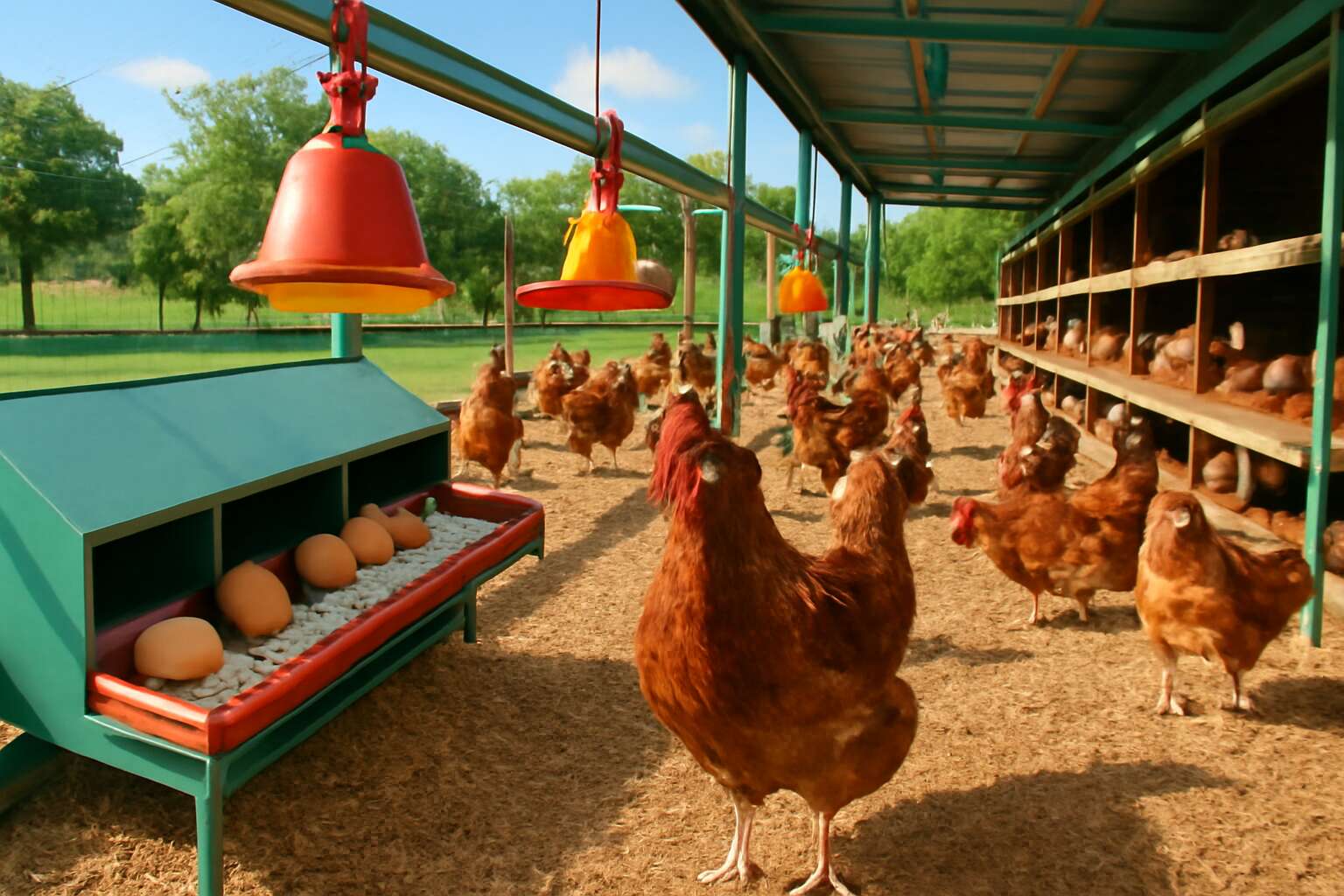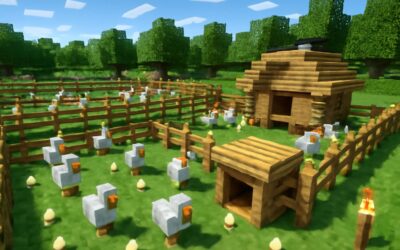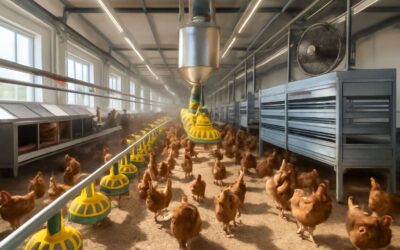Types of Chicken Farming Equipment
Housing and Shelter Equipment
In the delicate dance of chicken farming, the very foundation lies in the shelter—an orchestration of housing and shelter equipment that transforms a mere enclosure into a sanctuary of productivity. These structures are far more than simple coops; they are the heartbeat of efficient chicken farming equipment, designed to nurture health and vitality. When crafted with precision, housing becomes a fortress against the caprices of weather and predators, ensuring that every feathered inhabitant thrives under optimal conditions.
South African chicken farmers understand the importance of resilient shelter systems that blend durability with natural ventilation—an essential component of successful chicken farming equipment. From insulated coops to automated feeding stations, each element plays a vital role in fostering a harmonious environment. The right housing and shelter equipment not only safeguards the flock but also maximizes feed efficiency, reduces stress, and enhances overall productivity.
Consider these key features of effective poultry housing:
- Proper ventilation systems to maintain fresh air and prevent disease
- Insulation that balances temperature regulation with airflow
- Secure fencing to protect against predators and escape
- Automated lighting and watering systems for consistent care
Every piece of chicken farming equipment, from the simplest nesting box to complex climate control units, contributes to a symphony of care—an intricate ballet where each element sustains the health and vigor of the flock. When tailored thoughtfully, housing and shelter equipment become the silent guardians of a thriving poultry enterprise, echoing the promise of prosperity in every cluck and crow.
Feeding and Watering Equipment
In the intricate realm of chicken farming equipment, feeding and watering systems stand as vital pillars supporting the health and productivity of every flock. These systems are more than mere functional devices; they embody the harmony between efficiency and animal well-being. With South African farmers increasingly embracing automated solutions, the focus has shifted toward seamless integration of technology that ensures consistent nourishment and hydration.
Modern chicken farming equipment offers a variety of feeding options tailored to different production scales. From traditional troughs to automated feed dispensers, these tools optimize feed delivery while minimizing waste. Equally important are watering systems, which range from simple manual drinkers to sophisticated nipple drinker systems that promote cleanliness and reduce disease risk. Properly designed watering equipment not only guarantees fresh water but also encourages birds to drink more, supporting overall growth and vitality.
Consider these key features often found in effective chicken farming equipment for feeding and watering:
- Automated feed dispensers that regulate portion sizes and reduce labor
- Durable, easy-to-clean drinkers designed to prevent spillage and contamination
- Adjustable feeding and watering stations to accommodate different growth stages
In the grand dance of poultry management, each piece of chicken farming equipment for feeding and watering plays a crucial role, weaving efficiency with animal care. When thoughtfully selected and maintained, these systems become silent partners in nurturing a resilient, thriving flock—one that embodies the promise of sustainable poultry farming in South Africa.
Nesting and Egg Collection Equipment
Among the myriad of chicken farming equipment that transforms a simple coop into a symphony of productivity, nesting and egg collection equipment holds a special place. In South Africa’s vibrant poultry landscape, these tools are more than devices; they are the silent custodians of eggs, the treasures of every farm. Nesting boxes, crafted with comfort and cleanliness in mind, offer hens a sanctuary where eggs are laid naturally, reducing breakages and ensuring a smooth collection process.
Advanced egg collection systems, often integrated with automation technology, streamline the harvest, saving time and labor. These systems gently transfer eggs onto conveyor belts or trays, minimizing the risk of damage and contamination. For farms seeking efficiency, chicken farming equipment such as automatic nest box turners and egg conveyance systems are the magic wands that elevate productivity and hygiene.
By blending tradition with innovation, these equipment pieces help South African poultry farmers nurture resilient flocks, all while ensuring the eggs are collected with care—delivering freshness from hen to table with every sunrise.
Brooding Equipment
In the intricate ballet of chicken farming equipment, brooding equipment takes center stage, especially during those pivotal early days of a chick’s life. This stage demands precision and tenderness—two qualities that modern brooding systems excel at delivering. South African poultry farmers understand that the right brooding equipment isn’t just about warmth; it’s about creating a nurturing environment that encourages healthy growth and resilience. From thermostatically controlled heaters to insulated brooders, each piece plays a vital role in simulating the perfect mother hen’s embrace.
To truly optimize this phase, many farms turn to advanced technology, such as automatic temperature regulation systems, which adjust heat levels seamlessly. These innovations ensure the chicks remain comfortable, reducing stress and mortality rates. When considering chicken farming equipment, investing in versatile and durable brooding equipment is paramount. It’s the foundation upon which a thriving flock is built, transforming fragile hatchlings into robust layers ready to meet the demands of the South African market.
Cleaning and Maintenance Tools
In the relentless pursuit of optimal poultry production, one often overlooked battleground is the cleanliness and upkeep of chicken farming equipment. Without proper cleaning and maintenance tools, even the most advanced chicken farming equipment can become breeding grounds for disease, threatening the health of your flock. South African farmers know that durable, efficient cleaning tools are essential for maintaining biosecurity standards and prolonging the lifespan of equipment.
Effective cleaning begins with selecting the right tools. High-pressure washers, scrapers, and disinfectant sprayers are staples in any poultry farm arsenal. For those seeking precision, steam cleaners offer a germ-killing blast that penetrates stubborn grime without damaging surfaces. Regular maintenance—such as inspecting for wear and tear—ensures that equipment functions flawlessly, preventing costly breakdowns and pathogen spread.
To streamline the process, some farms utilize a systematic approach:
- Remove organic debris from surfaces.
- Apply suitable disinfectants using sprayers or misters.
- Use high-pressure washers to eliminate stubborn residues.
- Inspect and repair any damaged parts promptly.
Investing in quality cleaning and maintenance tools for chicken farming equipment isn’t just about hygiene; it’s about safeguarding your investment and securing the health of your flock. When properly maintained, your equipment continues to perform at its peak, ensuring a resilient and productive poultry operation amidst South Africa’s competitive market.
Key Features to Consider When Choosing Chicken Farming Equipment
Durability and Material Quality
When selecting chicken farming equipment, durability and material quality stand as the backbone of a successful and sustainable operation. In the rugged landscapes of South Africa, equipment that can withstand the unpredictable elements—be it scorching sun or sudden downpours—is essential. High-quality materials not only extend the lifespan of your chicken farming equipment but also ensure the safety and comfort of your birds. Imagine investing in equipment that endures seasons of wear and tear, reducing replacement costs and minimizing downtime—this is the true value of durability.
Opting for robust, corrosion-resistant metals and weatherproof plastics means your investment remains resilient over time. The choice of materials directly influences maintenance needs and operational efficiency. For instance, stainless steel components resist rust, making them ideal for outdoor settings, while sturdy plastics can be easily cleaned and sterilized to uphold hygiene standards. In the end, prioritizing material quality transforms a basic setup into a reliable fortress for your poultry, fostering both growth and peace of mind.
Automation and Efficiency
Efficiency and automation are game-changers in modern chicken farming. With South Africa’s poultry industry growing by over 4% annually, investing in smart chicken farming equipment can give you a competitive edge. Automated feeders and waterers reduce manual labor, ensuring consistent feed and hydration for your birds. This consistency minimizes stress and promotes healthier growth.
Advanced technology also allows for better monitoring of environmental conditions. Climate control systems integrated with your chicken farming equipment can adjust temperature and humidity automatically, creating an optimal environment for your flock. This not only enhances productivity but also reduces energy costs. Remember, streamlined operations lead to fewer disruptions and higher yields.
When choosing equipment, consider features like sensor integration and remote management capabilities. These innovations make management seamless and data-driven. In the end, the right combination of automation and efficiency in your chicken farming equipment transforms a basic setup into a high-performance operation that’s ready for the future!
Cost and Budgeting
Choosing the right chicken farming equipment is a vital step toward establishing a sustainable and profitable poultry operation. One of the most significant factors to consider is the initial cost versus your budget. High-quality equipment may require a larger upfront investment, but it often pays off through durability and energy efficiency in the long run. Balancing affordability with long-term value helps ensure your farm remains resilient against unexpected expenses.
Additionally, assessing the features that align with your specific needs can prevent unnecessary expenditures. For example, equipment with integrated sensor technology or remote management capabilities might seem costly initially but can save labor hours and reduce operational costs over time. When budgeting, it’s wise to outline essential equipment and prioritize those that directly impact productivity and bird health.
- Evaluate the durability and material quality of each piece of equipment.
- Consider future expansion plans to avoid frequent upgrades.
- Factor in maintenance costs and potential energy savings.
By carefully considering these aspects, you’ll make informed decisions that ensure your investment in chicken farming equipment supports the growth of your farm and the well-being of your flock in South Africa’s dynamic poultry industry.
Compatibility and Scalability
Choosing the right chicken farming equipment isn’t just about meeting current needs—it’s about future-proofing your poultry operation. Compatibility across different systems ensures seamless operation and reduces downtime, which is crucial in South Africa’s competitive poultry industry. Look for equipment that integrates easily with existing infrastructure or can be upgraded without major disruptions.
Scalability is equally vital. As your farm expands, your equipment should adapt—whether that means adding more feeders, waterers, or automated systems. Prioritize versatile chicken farming equipment that can grow with your flock, preventing costly replacements down the line. This foresight not only saves money but also streamlines management, giving you more time to focus on the health and productivity of your birds.
Incorporating flexible and compatible chicken farming equipment ensures your farm remains resilient, no matter the challenges ahead. Remember, the best investments are those that balance current demands with future growth potential.
Emerging Trends in Chicken Farming Equipment
Smart Farming Technologies
In the rapidly evolving world of chicken farming equipment, staying ahead of the curve means embracing smart farming technologies that transform the humble coop into a high-tech haven. Recent innovations are turning traditional poultry farms into automated, data-driven operations—think sensors that monitor temperature, humidity, and feed levels in real time. It’s almost like giving your chickens a luxury hotel experience, but with a very pragmatic twist.
Emerging trends highlight the integration of Internet of Things (IoT) devices that provide farmers with instant insights into flock health and productivity. This isn’t just about convenience; it’s about optimizing yield and reducing waste, which is crucial in South Africa’s competitive poultry market. For instance, automated feeding systems can adjust meal portions based on real-time data, ensuring chickens are neither starved nor overfed, thus conserving resources and boosting efficiency. As technology continues to advance, the future of chicken farming equipment looks set to become more intelligent, scalable, and downright astonishing.
To keep pace with these innovations, many farmers are adopting features like:
- Remote monitoring systems
- Automated climate control
- Smart lighting solutions
- Wireless data collection devices
All these advancements are helping poultry farmers enhance productivity while maintaining animal welfare, proving that even the most traditional farms can benefit from a little modern magic.
Eco-friendly and Sustainable Equipment
Emerging trends in chicken farming equipment are increasingly focused on eco-friendly and sustainable innovations. As the industry strives to reduce its carbon footprint, farmers are turning to equipment that minimizes environmental impact without sacrificing productivity. Green technology not only helps conserve resources but also appeals to a growing consumer demand for ethically produced poultry products.
One notable development is the integration of renewable energy sources into poultry operations. Solar-powered ventilation and lighting systems are now common, providing a sustainable alternative to conventional electricity. Additionally, eco-conscious chicken farming equipment often incorporates biodegradable materials and water-saving features that significantly lower waste and resource consumption.
Furthermore, the adoption of environmentally friendly disinfectants and waste management systems ensures that farms remain compliant with health standards while protecting surrounding ecosystems. This shift towards sustainability in chicken farming equipment demonstrates a clear commitment to responsible farming practices—an essential move as South Africa’s poultry industry faces increasing scrutiny from consumers and regulators alike.
To streamline this transition, some farms are implementing innovative solutions like:
- Biodegradable bedding and nesting materials
- Water recycling systems integrated with smart sensors
- Energy-efficient climate control units
By prioritizing eco-friendly and sustainable chicken farming equipment, farmers can enhance operational efficiency while championing environmental stewardship—an indispensable balancing act in today’s poultry industry.
Innovative Design and Materials
Innovation in chicken farming equipment is reshaping the industry at a rapid pace. Modern designs focus on enhancing efficiency while reducing environmental impact. Lightweight, corrosion-resistant materials are now common, making equipment more durable and easier to maintain. Farmers are increasingly adopting modular systems that allow for quick upgrades and customization, ensuring their operations stay flexible and scalable.
Emerging trends also include the integration of advanced materials like biodegradable composites. These materials not only extend the lifespan of equipment but also promote eco-friendly farming practices. For example, biodegradable nesting materials and water-efficient systems are gaining popularity among South African poultry farmers committed to sustainability.
To better understand these innovations, consider the following features gaining traction in chicken farming equipment:
- Smart sensors embedded in equipment for real-time monitoring
- Lightweight, durable plastics resistant to poultry waste and moisture
- Energy-efficient components that lower operational costs
These advancements demonstrate that the future of chicken farming equipment lies in smarter, greener, and more adaptable solutions—tailored to meet the demands of modern poultry farms.
Choosing the Right Equipment for Your Chicken Farm
Assessing Farm Size and Production Goals
In the delicate dance of chicken farming, selecting the right equipment is akin to choosing the perfect notes for a symphony. The size of your farm and your production goals are the foundational melodies that guide this harmony. Whether you envision a modest backyard flock or a sprawling commercial operation, each decision shapes the rhythm of your enterprise.
Assessing farm size isn’t merely about acreage; it’s about understanding the scope of your ambitions. Small-scale farmers might lean towards versatile, easy-to-maintain chicken farming equipment that ensures quality without complexity, while larger operations demand robust, scalable solutions that can handle increased throughput. Your production goals—be it fresh eggs or meat—must influence your choices, ensuring that the equipment aligns seamlessly with your vision.
- Determine the volume of chickens you plan to raise annually
- Evaluate the available space and infrastructure
- Match equipment durability and capacity to your expected output
In this intricate tapestry, the harmony between farm size and equipment choice is paramount. When crafted with foresight, your chicken farming equipment becomes an extension of your passion—facilitating growth, efficiency, and sustainability in every feathered step forward.
Budget Planning and Investment
In the pursuit of a thriving chicken farm, budget planning is the silent conductor guiding every decision. Every rand invested in chicken farming equipment must balance aspiration with reality, transforming vision into tangible progress. The allure of cutting-edge automation or eco-friendly innovations can be tempting, but understanding your financial boundaries ensures sustainability in the long run.
To make informed choices, many farmers create a comprehensive investment blueprint, emphasizing essential equipment that aligns with their scale and goals. For instance, prioritizing durable chicken housing and efficient feeding and watering systems can lay a solid foundation. When budgeting, consider not only the initial purchase price but also long-term costs—maintenance, energy consumption, and potential upgrades.
In the realm of chicken farming equipment, strategic allocation of funds fosters resilience and growth. By carefully selecting components that promise durability and scalability, farmers build an enterprise that embodies both passion and prudence. Every monetary decision echoes the heartbeat of a farm destined for success, blending practicality with the promise of the American Dream’s rural allure.
Supplier Selection and Quality Assurance
Choosing the right chicken farming equipment is akin to selecting the enchanted tools that breathe life into a thriving farm. The key lies in supplier selection—finding partners who offer not only quality but also a deep understanding of your unique needs. Trustworthy suppliers provide assurance through rigorous quality assurance processes, ensuring every piece of equipment withstands the rigors of daily use and climatic challenges inherent to South African farms.
When evaluating potential suppliers, consider their reputation for durability and innovation. An ideal vendor offers chicken farming equipment that melds traditional resilience with modern efficiency. To streamline your decision, ask for detailed specifications, warranties, and after-sales support. Remember, the finest equipment is a harmonious blend of robust materials and smart design—elements that promise longevity and adaptability as your farm evolves. Your investment in superior chicken farming equipment is ultimately an investment in sustainable growth and farm resilience, safeguarding your passion for poultry farming for generations to come.
Maintenance and Support
Choosing the right chicken farming equipment can make or break your operation. Proper maintenance and reliable support are vital to keep everything running smoothly. A well-maintained farm minimizes downtime and ensures optimal productivity. It’s essential to work with suppliers who offer comprehensive after-sales support, including parts availability and technical assistance. This support network helps you address issues swiftly, avoiding costly delays.
When selecting chicken farming equipment, consider durability and ease of repair. Equipment that’s built with high-quality materials withstands harsh South African climates and daily wear. Additionally, look for vendors that provide detailed warranties and responsive customer service. Investing in reliable equipment backed by excellent support creates a resilient farm capable of adapting to growth and changing conditions.



0 Comments